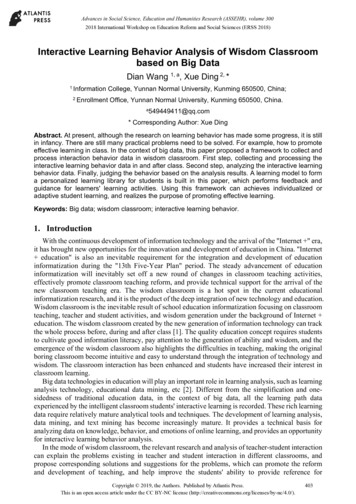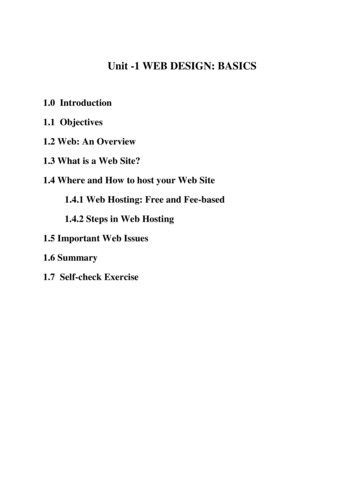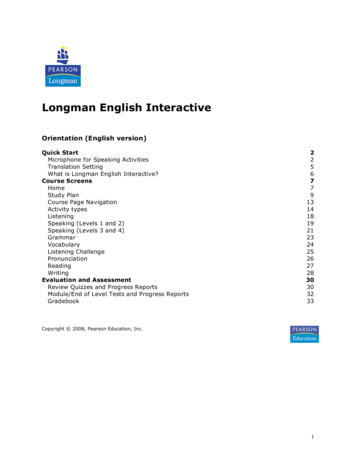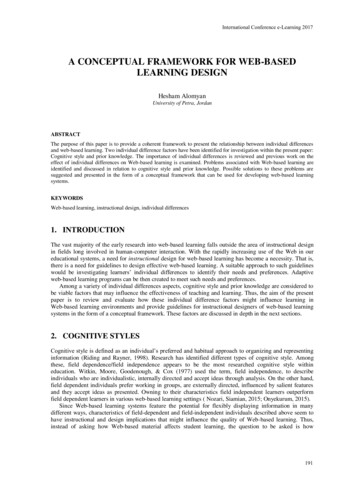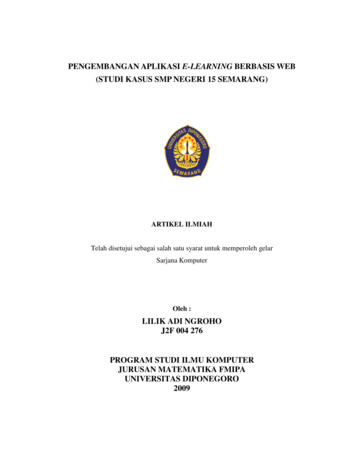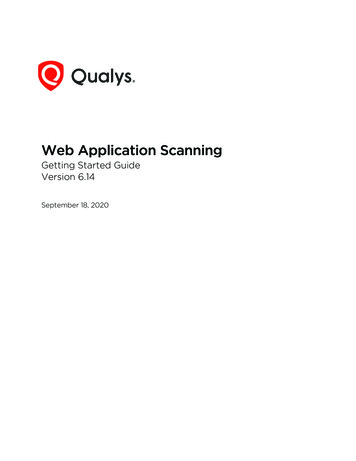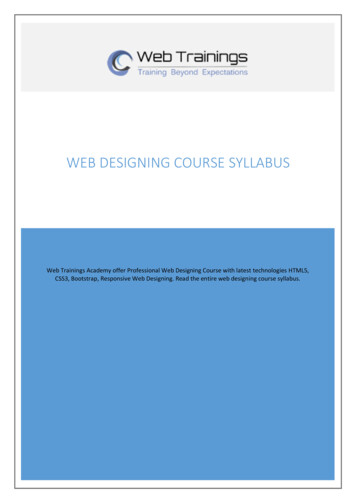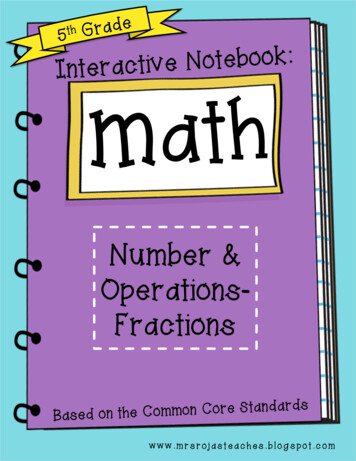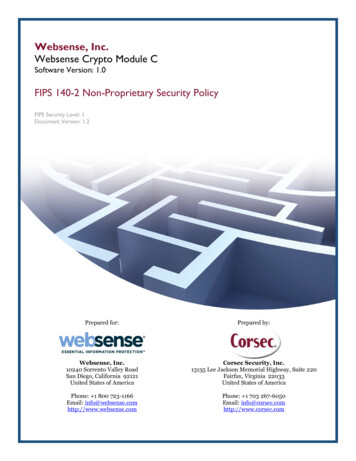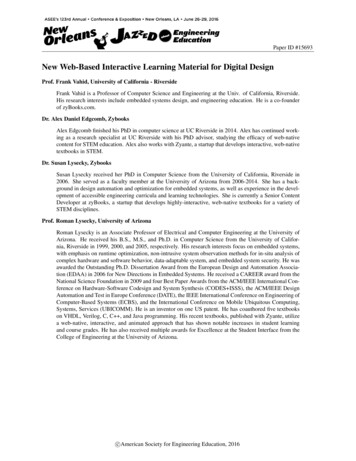
Transcription
Paper ID #15693New Web-Based Interactive Learning Material for Digital DesignProf. Frank Vahid, University of California - RiversideFrank Vahid is a Professor of Computer Science and Engineering at the Univ. of California, Riverside.His research interests include embedded systems design, and engineering education. He is a co-founderof zyBooks.com.Dr. Alex Daniel Edgcomb, ZybooksAlex Edgcomb finished his PhD in computer science at UC Riverside in 2014. Alex has continued working as a research specialist at UC Riverside with his PhD advisor, studying the efficacy of web-nativecontent for STEM education. Alex also works with Zyante, a startup that develops interactive, web-nativetextbooks in STEM.Dr. Susan Lysecky, ZybooksSusan Lysecky received her PhD in Computer Science from the University of California, Riverside in2006. She served as a faculty member at the University of Arizona from 2006-2014. She has a background in design automation and optimization for embedded systems, as well as experience in the development of accessible engineering curricula and learning technologies. She is currently a Senior ContentDeveloper at zyBooks, a startup that develops highly-interactive, web-native textbooks for a variety ofSTEM disciplines.Prof. Roman Lysecky, University of ArizonaRoman Lysecky is an Associate Professor of Electrical and Computer Engineering at the University ofArizona. He received his B.S., M.S., and Ph.D. in Computer Science from the University of California, Riverside in 1999, 2000, and 2005, respectively. His research interests focus on embedded systems,with emphasis on runtime optimization, non-intrusive system observation methods for in-situ analysis ofcomplex hardware and software behavior, data-adaptable system, and embedded system security. He wasawarded the Outstanding Ph.D. Dissertation Award from the European Design and Automation Association (EDAA) in 2006 for New Directions in Embedded Systems. He received a CAREER award from theNational Science Foundation in 2009 and four Best Paper Awards from the ACM/IEEE International Conference on Hardware-Software Codesign and System Synthesis (CODES ISSS), the ACM/IEEE DesignAutomation and Test in Europe Conference (DATE), the IEEE International Conference on Engineering ofComputer-Based Systems (ECBS), and the International Conference on Mobile Ubiquitous Computing,Systems, Services (UBICOMM). He is an inventor on one US patent. He has coauthored five textbookson VHDL, Verilog, C, C , and Java programming. His recent textbooks, published with Zyante, utilizea web-native, interactive, and animated approach that has shown notable increases in student learningand course grades. He has also received multiple awards for Excellence at the Student Interface from theCollege of Engineering at the University of Arizona.c American Society for Engineering Education, 2016
New Web Based Interactive Learning Material for Digital DesignFrank Vahid, Computer Science & Engin., Univ. of California, Riverside (also with zyBooks)Alex Edgcomb, zyBooks, Los Gatos, California (also with UC Riverside)Susan Lysecky, zyBooks, Los Gatos, CaliforniaRoman Lysecky, Electrical and Computer Engineering, Univ. of Arizona (also with zyBooks)AbstractStudying college level digital design involves both the learning of concepts and the developingof skills, as with various other engineering topics. For example, converting a Boolean function toa minimized circuit not only involves learning concepts of Boolean algebra, but also developingskills in creating truth tables, minimizing equations via K maps, and converting equations tocircuits. Sequential design involves not only learning concepts of state machines, but alsodeveloping skills in describing behavior as a state machine, and converting to a controller.Developing skills especially benefits from practice, via homework. But, assigning and gradingsufficient homework problems is a challenge for instructors, due to limited time and resources.Furthermore, traditional grading of homework has long feedback cycles, which is not conduciveto learning.We thus created new web based interactive learning material for digital design, to replaceexisting textbooks. To help master concepts, the material makes extensive use of interactiveactivities like animations and learning questions. To help master both concepts and skills, thematerial integrates web based simulators, and a homework system that auto generates exercises,and that immediately auto grades student answers while also providing feedback.The material has been used at over 40 universities and several thousand students thus far. Thispaper describes the various items used throughout the material to help students both learnconcepts and develop skills.IntroductionCollege courses on digital design, also called logic design or digital systems, continue to berequired by programs in computer engineering, electrical engineering, and computer science.Studying digital design provides students with a solid understanding of how computers workfrom the bottom up, and forms the basis for study of computer architecture, both of whichenhance student confidence and maturity, and can lead to better software designers whounderstand hardware resources. And, some students embark on careers involving digital design,perhaps creating interface logic, custom accelerator logic, or new general purpose computing
architectures, using custom/semi custom chips or field programmable gate arrays (FPGAs).Like many computing and engineering topics, studying digital design involves a combination oflearning concepts and developing skills. For example, students must learn the concepts ofBoolean algebra that involve various properties, and students must develop skills in applyingthose properties to minimize logic equations. Active learning, such as answering questions orcreating designs, is known to be more effective than less active learning, such as listening to4 long lectures or reading numerous pages of text . Active learning is more effective not only fordeveloping skills, but also for learning concepts.Traditional textbooks essentially represent a passive learning experience; the reading andviewing of numerous pages of text and figures is akin to listening to a lengthy lecture. As such,students (especially today's students, but past students as well) often don't learn well fromreading textbooks. In part for that reason (along with other reasons like rising prices), ouranalyses and those of others show that about a third of students today don't even acquire the"required" textbook in a digital design course, and those that do don't make extensive use of thebook.Furthermore, instructors are finding that grading assigned homework is becoming even harderthan before, as grading resources have shrunk (especially since the budget crises starting in2008). Attempts to deal with such shrinking resources tend to be ineffective; not gradinghomeworks and instead telling students the homework is for their own good leads most studentsto not do the homework, and grading only a subset of homework problems results in manydisgruntled students upset that their work was "wasted" or their low score is based on just acouple non representative problems. Also, even with plenty of grading resources, the long timefeedback loop reduces the learning opportunity, since students don't realize mistakes until gradeditems are returns several days (or even weeks) later, when the student has moved on to othermaterial.As a result of the above problems, we embarked in 2014 on creating new digital design material,utilizing the power of the web to create interactive material. This paper summarizes severalfeatures of the interactive material for key digital design topics: Boolean algebra, combinationalcircuits, K maps, finite state machines, high level state machines, and datapaths. The paperdescribes an integrated homework system built around those features. The interactive material ofcourse covers digital design topics not included in this paper for space reasons, such as creatingsequential circuits to implement FSMs.Having its roots in 2014 rather than in the 1980's when digital design dealt with much smallercircuits, the material also strives to teach a modern view of digital design, going bottom up as
before, but being sure to reach register transfer level design as promptly as reasonable.Boolean algebraDigital design is based on the mathematics and properties of Boolean algebra. Gainingunderstanding of and experience with those properties is among the first learning tasks. As such,we developed a new web based tool to allow a student to immediately apply the properties ofBoolean algebra to equations. The tool, shown below, presents a pallette of properties, and thenauto generates a goal equation and an initial equation. The student must apply propertiesone by one to convert the initial equation into the goal equation. Another tool version has moreproperties, and allows the properties to be applied left to right (as below) or right to left as well.The tool is integrated within the web based learning material. A homework systemauto generates successively harder problems for a student to solve. Scores per student arereported to the instructor.Figure 1: Boolean algebra tool. (a) User prompted to select a property. Goal and initial equation shown. (b) Userselects terms. (c) Continue applying properties to reach goal.Combinational circuitsA student next learns how logic gates that implement Boolean algebra's operations of AND, OR,and NOT can be connected as combinational circuits to implement Boolean functions. Normally,
a student would learn Boolean functions and combinational circuits conceptually in lecture andvia homeworks, while any practice is done separately in labs having circuit simulation tools.Instead, we developed a combinational circuit simulator, shown below, that executes in the webbrowser. Nearly every example circuit, starting with when an AND gate is first introduced, isshown not as a static figure, but loaded in the circuit simulator. Thus, students can immediatelysee how the circuits operate dynamically. Additionally, homework problems are built on thesimulator: A Boolean function is auto generated, and the student must create an equivalentcircuit, with equivalence being automatically checked. If the student's circuit is wrong, thedifference is shown, and then another function of the same complexity is auto generated. If thestudent's circuit is correct, a progressively harder function is generated. Such a "progression tool"is a common pattern in the homework problems in the material, typically with about 5progression levels.Figure 2: Combinational circuits. (a) Circuit simulator, (b) Auto generated, auto graded homework built on top ofthe simulator, with (c) increasingly harder problems.K mapsK maps are a graphical technique for minimizing two level logic. While no longer a job task,K maps are quite useful for learning, giving students insight on how algebraic techniques areapplied to yield minimized circuits. We developed several K map progression tools forhomework purposes, including finding minterms on a K map, and writing the term thatcorresponds to a cell or circle on a K map. Below is the most advanced of those tools, whichasks a student to create a minimized two level equation by drawing the fewest and largest circles.The tool starts with simple problems like a single 1 on the K map, and presents progressively
harder problems like having 1's that wrap left right or having three adjacent 1's (so the middle 1should be included in two circles). The tool automatically shows how a circle corresponds to aseries of applied algebraic properties. If the student didn't draw circles yielding minimizedequations, the tool shows the correct circles.Figure 3: Minimization via K maps. (a) After student fills in the K map, the corresponding algebraic minimizationis shown. (b) The corrected K map is shown if the equations are not minimized,.Finite state machines (FSMs)An FSM describes desired behavior of a sequential circuit, just as an equation describes desiredbehavior of a combinational circuit. Students often have difficulty understanding FSMs becausean FSM represents a dynamic thing, but is usually just shown statically. Instructors try to showan FSM's dynamic nature by pointing to (or coloring) one state at a time in lectures. We built abrowser based FSM simulator. Many examples are shown in the simulator rather than as a staticfigure, so that students can simulate the FSM to see dynamic behavior (and alter the FSM to seethe impact). A progression tool is also built on the simulator to provide homework problems,where the student is asked to create an FSM having particular behavior. Problems areauto generated and get progressively harder, and are auto graded.
Figure 4: FSM example shown in the simulator with suggested extensions.Figure 5: FSM progression tool (homework).
High level state machines (HLSMs)Being written for modern digital design, the material includes coverage of register transfer level(RTL) design. An HLSM describes the designed behavior of an RTL design. The materialincludes an HLSM simulator, similar to the FSM simulator, as well as a progression tool built onthe simulator for homework.Figure 6: HLSM simulator.Datapath buildingA key part of RTL design is designing a datapath able to support an HLSM's data operations(after which the HLSM can be converted to a controlling FSM). Thus, we developed a datapathbuilder. The resulting datapath can be simulated by clicking on the control and clock input valueson the left. A progression tool is built on the simulator, for homework purposes.
Figure 7: Datapath simulator.HDL simulationMany digital design courses introduce hardware description languages (HDLs), like Verilog orVHDL. In the future, we hope to incorporate a full HDL simulator, likely via a window to aremote server (as we do for learning materials on C, C , Java, Python, and MATLAB).Presently, we include a constrained simulation for specific topics, like shown below for acombinational process involving a single assignment statement.
Figure 8: Mini HDL simulation.Auto generated auto graded homeworkIn general, our philosophy has been to shift emphasis away from creating end of sectionexercises and solution manuals, and instead spend (much more) effort to create auto generated,auto graded homework activities, mostly in the form of progression tools. Reasons include: Illicitly posted solutions to end of section exercises for many textbooks are availableonline today. Plus, a major college focused web company created solutions to suchexercises, selling them to students, yielding a top revenue source for the company. Auto generated problems tend to be harder to copy among students, since each studentgets unique problems. Our analyses also show that students will earnestly attemptwell designed learning activities, without trying to copy answers even when thoseanswers are easily available. The progression tool approach presents simpler problemsfirst and progresses to harder problems, and often provides solutions/hints to wronganswers followed by generating a similar difficulty problem; as such, the tool "adapts" tothe student, providing multiple problems until the student gets the problem right, beforeprogressing to harder problems. Cheating is thus mostly unnecessary.
Students get immediate feedback. An advantage is that students are immediatelyinformed of mistakes, can learn from them, and correct them. A disadvantage is thatstudents may repeatedly guess until completing the activity. Automated homework eliminates much or all homework grading for instructors, freeinginstructors to perform higher value activities with students, while also enablinginstructors to assign the amount of homework the teacher feels is best for students,without worrying about grading.Animations, learning questions, and less textThe above discussion focused on the built in web based simulators and automated homeworkproblems in the material. In addition, the material has been written natively for the web, and thushas a very different appearance than a textbook ported to the web. In particular, whereas atextbook author's only available teaching mechanisms are text and figures, a web material authoralso has available interactive mechanisms like animations, learning questions, and tools. Thus,natively writing for the web results in more subject being taught via those other mechanisms,necessarily resulting in less text and fewer static figures. The result is a rather different looking"book", which at first glance appears light or supplementary, but instead has much of thelearning done in a different form (which our studies show yield improved learning outcomes).Independently, for any text that is written, we have focused on using the fewest words possible.Such minimal text writing is harder than writing more text. In fact, often the text is first writtenin a lengthier form, and then reduced without losing meaning. One might consider the effort thatgoes into a newspaper headline, to understand how hard minimizing text can be. Minimal text3 has been shown to improve learning by over 100% ; students are more likely to read minimaltext carefully and thus learn the concepts therein.Below is an example discussion, on the topic of timing diagrams. A few lines of text define theconcept. The animation dynamically shows the timing diagram growing to the right (which can'tbe shown in this static paper, obviously). The learning questions in this case replace what wouldnormally be an example presented as text and a figure, instead engaging the student to completethe various parts and showing a brief explanation for each part; such questions are not quizzes orhomework, but rather a replacement for lengthier text. As an analogy, rather than lecturing to thestudent for 10 minutes (via several pages of text and figures), the material lectures for a fewminutes (via minimal text), and then has a dialog with the student (via the learning questions andtheir explanations). We utilize various types of learning questions: true/false, multiple choice,short answer, and matching. In all cases, explanations are included (as well as hints); especiallyexplaining why a wrong answer is wrong, thus breaking down student misconceptions (whicheducation research has found is crucial to enable learning).
Figure 9: The material teaches through less text, in favor of more interactive animations and learning questions.Figure 10: Learning questions are not quizzes/homeworks, but a more engaging/effective replacement for reading.
Time to developThe interactive material described above is harder to develop and maintain than traditionaltextbook material (two of the authors have published traditional textbooks). As one obviousindicator, the material is often developed first by writing text and drawing figures (as for atraditional textbook), followed by an additional stage of replacing some text/figures by ananimation, and replacing other text by learning questions. Learning questions especially requiremuch attention. Furthermore, focusing on minimal text requires even more time.Separately, developing the simulators and progression tools required software development time.Some simulators required about 2 3 days of development, while others required several weeks.Furthermore, building a progression tool on top of a simulator typically requires another 2 3 daysper tool. In addition to such software development time, the authors must also contribute time todefine and refine each simulator and tool, typically totally about 4 8 hours per item.Beyond initial development, interactive material is harder to maintain. Software must sometimesbe upgraded in response to browser updates, or adjusted to work around browser bugs. Softwarebugs of course must be fixed. Furthermore, being web based material, the opportunity exists to5 receive feedback instantly from users, and we take full advantage of that opportunity . Thus, thematerial is continually being updated to be clearer, and fix any errors (rarely does more than oneperson ever see an error).In short, we estimate that developing the web based digital design material required about 2xmore initial effort (well over 1500 hours), and then incurs ongoing maintenance/upgrades ofperhaps 6 10 hours per month on average. However, we believe that such web based publishingof interactive material represents the future of college level learning material.ExperiencesThe material is published as a zyBook (see zyBooks.com). The material has been used at over 40universities since being published in 2014, with the number growing. Feedback from instructorsand students has been very positive.A common problem for instructors is that instructors know that students learn throughhomework, but grading such homework is extremely resource intensive. The above describedmaterial has about 1,000 short learning questions (participation activities), and about 100auto generated challenge activities (homework like problems such as using a K map forminimizing logic, or drawing a simple circuit or state machine), all auto graded. Grading suchactivities manually, as done in the past, would have required approximately 20 sec per learning
question and 1 minute per challenge activity, totalling 1000*0.2 100*1 300 minutes ofgrading time per student. Our class at has about 100 students per class, meaning gradingtime of 300 * 100 30,000 minutes or 500 hours. However, our teaching assistant time is 300hours for the entire class, and of course TAs can spend all their time grading either. What thushappened before was that far less homework would be assigned than was desired, totalling about50 hours for the class' duration. Furthermore, feedback would not be returned until at least aweek later, diminishing the usefulness. With the new interactive material, students can beassigned sufficient tasks for before class (participation activities) and after class (challengeactivities), and yet no teaching resources are spent on creating or grading such items.Furthermore, our previous analyses show that about 95% of students earnestly work on thoseactivities, as opposed to cheating the system to earn points. Completion rates of the activities bystudents are nearly 100%.Several instructors report substantially improved student outcomes. In previous work, weshowed via randomized controlled studies that students learn more from such interactive1material (16% improvement, with the initially weakest students showing 64% improvement),and via cross semester analyses showing that classes who switch to such interactive material see2 student grades improve by about 1/3rd a letter grades . Via surveys, we have found that 1/3 ofstudents previously acquired the "required" textbook, whereas nearly 100% acquire suchinteractive material (due to activity completion contributing to their grade).ConclusionsWe described new web native learning material for digital design, intended to replace existingtextbooks, as well as to provide an integrated automated homework system. The material isintended to help students learn concepts while also developing skills related to digital design.The auto grading not only provides immediate feedback, but greatly reduces the teachingresources needed to create and grade homework assignments.AcknowledgementsThis work was supported in part by the National Science Foundation (CPS1136146), theNational Science Foundation's Small Business Innovative Research (SBIR) program (1315094and 1430537), and a Google faculty research award. We are sincerely grateful for their support.
References[1] Edgcomb, A. and F. Vahid. Effectiveness of Online Textbooks vs. Interactive Web Native Content, Proceedingsof ASEE Annual Conference, 2014.[2] Edgcomb, A., F. Vahid, R. Lysecky, A. Knoesen, R. Amirtharajah, and M.L. Dorf. Student PerformanceImprovement using Interactive Textbooks: A Three University Cross Semester Analysis, Proceedings of ASEEAnnual Conference, 2015.[3] Edgcomb, A., F. Vahid, and R. Lysecky. Students Learn More with Less Text that Covers the Same Core Topics,Frontiers in Education Conference (FIE), IEEE, 2015[4] Freeman, S, S.L. Eddy, M. McDonough, M.K. Smith, N. Okoroafor, H. Jordt, and M.P. Wenderoth. Activelearning increases student performance in science, engineering, and mathematics. Proceedings of the NationalAcademy of Sciences, 111.23, pgs 8410 8415, 2014.[5] Vahid, F., D. de Haas, S. Strawn, A. Edgcomb, S. Lysecky, and R. Lysecky. A Continual ImprovementParadigm for Modern Online Textbooks, Proceedings of International Conference on Education, Research, andInnovation (ICERI), 2015.AppendixThe Digital Design zyBook's table of contents is provided below. New chapters and tools arebeing developed.1. Combinational Logic1.1 Voltage and current1.2 Switches1.3 CMOS transistors1.4 Transistors and gates1.5 Boolean algebra1.6 Boolean algebra and digital design1.7 Digital circuit simulator1.8 Timing diagrams1.9 Equations to/from circuits1.10 Basic properties of Boolean algebra1.11 Sum of products form for circuits1.12 Binary and counting1.13 Sum of minterms form1.14 Truth tables1.15 Why study digital design1.16 Basic circuit drawing conventions2. Combinational Logic II2.1 Two level combinational logic minimization2.2 K maps: Introduction
2.3 More K maps2.4 More Boolean algebra: DeMorgan's Law2.5 XOR and XNOR gates2.6 Universal gates2.7 Muxes2.8 Decoders3. Sequential Logic3.1 SR latches3.2 Flip flops3.3 Basic registers3.4 FSMs3.5 FSM simulator3.6 Capturing behavior with FSMs3.7 FSMs to circuits3.8 Circuits to FSMs3.9 Reducing states3.10 State encodings3.11 Mealy FSMs3.12 FSM issues3.13 Controller clock frequency4. Datapath Components4.1 Adders4.2 Signed numbers in binary4.3 Subtractors4.4 Comparators4.5 N bit muxes4.6 Load registers5. RTL Design5.1 HLSMs: Introduction5.2 HLSMs with variables5.3 HLSMs with a loop5.4 HLSM simulator5.5 Capturing behavior with HLSMs5.6 Datapaths for HLSMs5.7 HLSMs to circuits: RTL design5.8 RTL timing5.9 Assigning and reading variables
6. Datapath Components II6.1 Tradeoffs6.2 Carry lookahead adders6.3 Multipliers (array style)6.4 Register files6.5 Multi function registers6.6 ALUs7. Verilog HDL7.1 Introduction to HDLs7.2 Combinational logic7.3 Identifiers7.4 Testbench7.5 Sequential logic7.6 RTL design8. VHDL8.1 Introduction to HDLs8.2 Combinational logic8.3 Identifiers8.4 Testbench8.5 Sequential logic8.6 RTL design
New Web-Based Interactive Learning Material for Digital Design Prof. Frank Vahid, University of California - Riverside Frank Vahid is a Professor of Computer Science and Engineering at the Univ. of California, Riverside. His research interests include embedded systems design, and engineering education. He is a co-founder of zyBooks.com.
